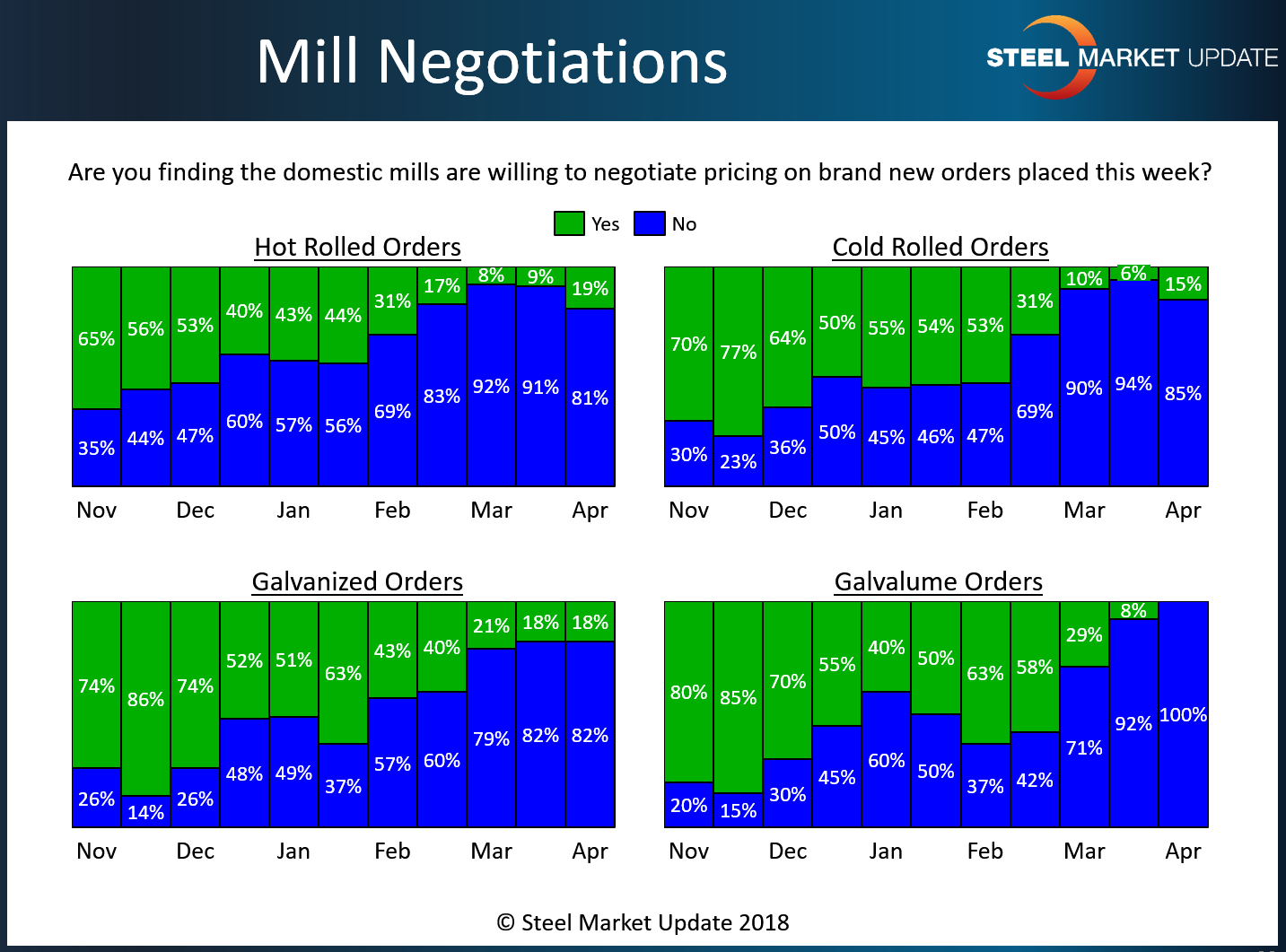SMU Data and Models

Steel Mill Negotiations: Mills Still Hold the Upper Hand
Written by Tim Triplett
April 4, 2018
Steel Market Update conducted our early April survey earlier this week. One of the key proprietary products produced is how buyers and sellers of flat rolled represent the mill negotiation position. Are steel mills willing to negotiate spot prices on new orders at this time? Buyers responding to this week’s SMU market trends questionnaire reported a slight loosening in mill negotiations. A few more buyers of hot rolled and cold rolled steels said they have found mills willing to bend a bit on price, especially for large orders. However, from a historical perspective, steel mills continue to be stingy on hot rolled, cold rolled, galvanized and Galvalume spot pricing.
By market segment, 19 percent of hot rolled buyers said they have found mills willing to negotiate, compared with just 9 percent two weeks ago—a 10-point swing. But the vast majority, 81 percent, said the hot rolled mills are still holding firm.
In the cold rolled segment, 15 percent said they have found some mills willing to talk price. That’s up significantly from just 6 percent in mid-March. Currently, 85 percent reported mill prices on cold rolled as non-negotiable.
In the galvanized sector, there was little change over the past two weeks as 82 percent of respondents said the mills are now standing firm on galvanized prices, while 18 percent said some mills are still open to negotiation on coated products. Nearly all Galvalume buyers reported that mills are unwilling to compromise on Galvalume prices.
Buyers continue to tell SMU that few mills are flexible on price, and supplies are tight. “We are still seeing controlled order entry for spot tons,” said one buyer of hot rolled. “There is a short window to execute the order if you want the spot tons before they go to someone else.”
Note: SMU surveys active steel buyers twice each month to gauge the willingness of their steel suppliers to negotiate pricing. The results reflect current steel demand and changing spot pricing trends. SMU provides our members with a number of ways to interact with current and historical data. To see an interactive history of our Steel Mill Negotiations data, visit our website here.

Tim Triplett
Read more from Tim TriplettLatest in SMU Data and Models

SMU Survey: Buyers’ Sentiment rebounds from multi-year low
Both of SMU’s Steel Buyers’ Sentiment Indices edged higher this week. Current Sentiment rebounded from a near five-year low, while Future Sentiment rose to a two-month high

SMU flat-rolled market survey results now available
SMU’s latest steel buyers market survey results are now available on our website to all premium members.

SMU Survey: Sheet lead times pull back after early-June blip, plate holds
Following the uptick seen two weeks ago, lead times eased this week for all four sheet products tracked by SMU, while plate lead times held steady, according to this week’s market survey.

SMU Survey: Pricing power abruptly shifts to steel buyers
The majority of steel buyers responding to our latest market survey say domestic mills are more willing to talk price on sheet and plate products than they were earlier this month. Sheet negotiation rates rebounded across the board compared to early June, while our plate negotiation rate hit a full 100%.

Service centers: Mill orders down marginally in May
SMU’s Mill Order Index (MOI) declined for a third straight month in May, but only marginally.

